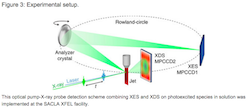Several researchers have come a step closer to producing solar fuel using artificial photosynthesis. The Lund University team has successfully tracked the electrons’ rapid transit through a light-converting molecule. The goal of the study is to discover a way to make fuel from water using sunlight, similar to photosynthesis. Researchers around the world are attempting to borrow ideas from photosynthesis in order to find a way to produce solar fuel artificially.
“Our study shows how it is possible to construct a molecule in which the conversion of light to chemical energy happens so fast that no energy is lost as heat. This means that all the energy in the light is stored in a molecule as chemical energy,” said Villy Sundström, professor of Chemical Physics at Lund University.
 Today solar energy is harnessed in solar cells and solar thermal collectors. Solar cells convert solar energy to electricity and solar thermal collectors convert solar energy to heat. However, producing solar fuel, for example in the form of hydrogen gas or methanol, requires entirely different technology. The idea is that solar light can be used to extract electrons from water and use them to convert light energy to energy rich molecules, which are the constituent of the solar fuel.
Today solar energy is harnessed in solar cells and solar thermal collectors. Solar cells convert solar energy to electricity and solar thermal collectors convert solar energy to heat. However, producing solar fuel, for example in the form of hydrogen gas or methanol, requires entirely different technology. The idea is that solar light can be used to extract electrons from water and use them to convert light energy to energy rich molecules, which are the constituent of the solar fuel.
“A device that can do this – a solar fuel cell – is a complicated machine with light-collecting molecules and catalysts,” said Sundström.
In the current study, Professor Sundström and his colleagues have developed and studied a special molecule that can serve as a model for the type of chemical reactions that can be employed in a solar fuel cell. The molecule comprises two metal centres, one that collects the light and another that imitates the catalyst where the solar fuel is produced. The researchers have managed to track the path of the electrons through the molecule in great detail. They measured the time it took for an electron to cross the bridge between the two metal atoms in the molecule. It takes half a picosecond, or half a trillionth of a second.
“In everyday terms, this means that the electron flies through the molecule at a speed of around four kilometres a second, which is over ten times the speed of sound,” explained Sundström.
The researchers were surprised by the high speed as well as that the speed appears to be highly dependent on the type of bridge between the atoms. In this study, the speed was 100 times higher than with another type of bridge tested.
“This is the first time anyone has managed to track such a complex and rapid reaction and to distinguish all the stages of the reaction,” Sundström noted about the study, which has been published in the journal Nature Communications.
The study is a collaboration between researchers from several departments at Lund University and from Denmark, Germany, Hungary, Japan and the USA. The measurements were performed in Japan at the SACLA X-ray FEL in Harima, Japan, one of only two operating X-ray free-electron lasers in the world.

